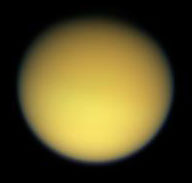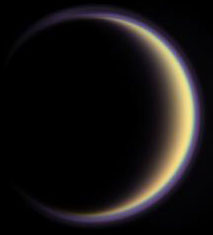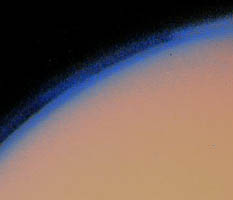|
|
TITAN
Larger than the planets Mercury and Pluto and the second largest moon in the solar system (after Jupiter’s Ganymede), Titan is the only known moon in the solar system with a substantial atmosphere. Its atmosphere is largely nitrogen with a small amount of methane and a variety of other hydrocarbons—organic compounds that give it an orange color. The smoggy atmosphere obscures the moon’s surface when viewed at visible light wavelengths, making Titan one of the most mysterious objects in the solar system.
The Cassini-Huygens mission was designed to penetrate Titan’s atmosphere in several ways: First,
Cassini
’s cameras can view Titan at infrared wavelengths, which allows a look through the haze down to the surface. Secondly, the spacecraft is using imaging radar to map the moon’s surface, and scientists hope that it will be able to map 10 percent to 20 percent of the surface during the four-year mission. Meanwhile, the
Huygens
probe descended through the atmosphere in January 2005, gaining a wealth of new information about the atmosphere itself as well as about the surface of Titan. [See
Updates.
]
Exploring Titan is a primary objective of the mission because scientists think that it may resemble the early Earth. If so, Titan and its hydrocarbon-laced atmosphere may provide chemical clues to life’s inception here.
|














